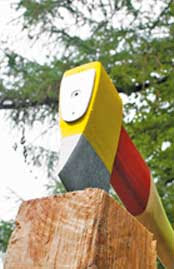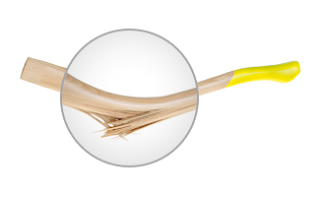
There is a wealth of information about axes on the internet, but here's a 'quick n dirty' bullet pointed guide that gives you as much info as possible in the briefest form I could manage. If you still have questions please feel free to drop me a line and I'll do my best to help.
Types of AxeFelling Axes: Thin blades for slicing through the fibres of the timber.
Splitting Axe: Axes with fat triangular heads for driving timber apart along the fibres.
Universal: Halfway between a felling axe and a splitting axe and surprisingly effective at both jobs.
Hatchet: Small highly accurate tools for trimming and fine splitting.
Blade ShapeBroad: Broad faced felling and universal axes tend to work better on softwoods like pines and firs.
 Narrow
Narrow: Blades with a short cutting edge concentrate the power and are generally better for harder timbers.
 Length vs. Mass
Length vs. MassThe power of an axe blow is a function of the head weight, the handle length and the amount of energy the user puts into the swing.
Heavy head: Lots of power and momentum, takes more effort to use.
Light head: Easy to wield, but less effective.
Long handle: Multiplies the energy of the swing
Short handle: Greater accuracy
A big heavy head on a long handle with a skilful and fired up user (eg
OX 440 H-2708 Competition Sport Axe) will make the maximum amount of progress in the minimum amount of time but is exhausting to use.
A relatively light head with a long handle (eg
OX 16 H-1008 Iltis Canadian Felling Axe ) will give the most efficient transfer of the users energy into cutting power but may require practice to control.
A relatively heavy head on a short handle (eg OX
395 E-601 Carpenter’s Bundle Axe) gives the best possible accuracy.
A relatively light head on a short handle (eg
OX 25 H-0806 Harz Pattern Universal Axe) is light to carry, easy to wield and accurate, although the size of workpiece that can be tackled is limited.
Handle Materials Ash
Ash: Has a very high strength to weight ratio (which is why it was used to make the frame for the Wright Flyer and still is used to frame cars like the Morgan +4). A very traditional timber for axe handles its only drawback is that when it does break it tends to break in two.
Hickory: (shown above) is massively strong stuff, good quality Hickory (the best comes from North America) is capable of 3-4 times the physical loading of Ash. It also has a very long fibre structure which means that it splinters apart but is unlikely to break fully in two.
Fibreglass: Modern synthetic handles are virtually unbreakable, immune to the cold and wet and on paper they seem the obvious choice. They just don't have quite the same feel as wood though.
SharpeningAcute angles: (typically found on felling axes) are sharper but more delicate.
Obtuse angles: (typically found on splitting axes) will be more durable.
Axes should be sharpened with convex bevels, which are stronger than flat or hollow ground ones.
Axes should never be reground on a powered grinder. If you get a big ding in the edge an aggressive file is the best way to remove it.
SafetyNo steel on steel. Hitting two pieces of hardened steel together can cause chips of steel to fly off. By all means drive aluminium, plastic or wooden
wedges with the back of a splitting hammer or hit steel axe heads or wedges with a polyamid or wooden mallet, but no steel on steel please.
Eye protection: Speaks for itself, big impacts, unpredictable materials, one pair of eyes.
Gloves: Not woolly ones,
proper rubberised work gloves that give an effective grip and provide some protection against splinters.
Check your equipment: Make sure that the head is securely fixed to the handle and check the handle for any signs of damage before starting work – every single time.
If it doesn’t feel safe don’t do it: Think about where the axe will go if you miss or the material moves, if a body part features anwhere in the plan for stopping the axe – make a new plan. A knee high chopping block is an essential safety aid for chopping.











